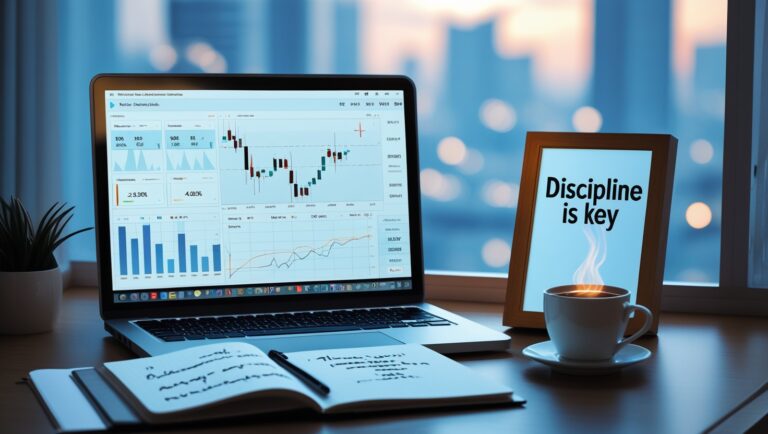The Psychology Behind My Trading Routine
The Psychology Behind My Trading Routine
I used to think that trading success came down to finding the perfect setup or learning the right strategy. But over time, I realized something deeper was at play: my mindset was affecting my results more than any chart pattern ever did.
The truth is, trading is mostly psychological. My emotions, habits, and discipline all show up the moment I open a chart. That’s why I don’t just have a trading strategy — I have a trading routine built around psychology.

Table of Contents
My Routine Starts Before the Market Opens
My trading day doesn’t start at 9:30AM — it starts with how I feel that morning. If I wake up rushed, distracted, or scattered, I know I’m not in the best state to trade. So I take time to clear my mind, review my plan, and mentally rehearse my setups.
I’ve learned that my mindset shapes my trades. If I feel fear, I hesitate. If I feel FOMO, I chase. But if I feel calm and focused, I wait for the right opportunity. That’s why psychology comes first — strategy comes second.
Discipline Is a Muscle, Not a Mood
There were times I’d follow my rules for a few days, then throw them out the window the moment I had a red day. That’s not a strategy — that’s gambling. Now, I treat discipline like a non-negotiable part of my routine.
Whether I’m winning or losing, I follow the same steps. I stick to my checklist, follow my rules, and avoid anything outside of my edge. That consistency keeps my emotions in check and my performance stable.
I Track My Emotional State Like I Track My Trades
I don’t just log my entries and exits — I also track how I felt during each trade. Was I confident or uncertain? Was I trading from a place of clarity or revenge? Over time, this helped me spot emotional patterns that were hurting my performance.
Once I understood my own psychology, I stopped being shocked by my mistakes. I saw the warning signs earlier — and started correcting them before they became expensive.
My Routine Keeps Me Grounded
My trading routine includes a pre-market ritual, a focused trading window (usually the first hour), and a shutdown process afterward. Once I’m done trading, I step away. No revenge trades. No late-day impulsive entries. Just clean execution — then disconnect.
This isn’t just for discipline — it’s for mental health. If you trade all day, you’re constantly under pressure. That stress builds up. My routine gives me space to recover, reflect, and recharge so I can stay sharp.
Want to See the Full Strategy Behind My Calm, Focused Trading?
Everything I’ve learned — from the mindset to the setups I wait for — is inside this ebook:
👉 Pay Your Bills with Stocks
I don’t believe in hype or signals. I believe in structure, discipline, and keeping things simple. That’s what I use to grow my account and cover my bills with just a few trades a week.
Final Thoughts
Your trading routine isn’t just about when you click buy or sell — it’s about the mental framework you build around your process. If you don’t manage your emotions, they will manage your account.
The deeper I got into trading, the more I realized I wasn’t fighting the market — I was fighting myself. And the more I structured my day, my thoughts, and my expectations, the better my results got.
If you’re struggling with inconsistency, it might not be your strategy. It might be your psychology. Fix that — and everything else starts to fall into place.
One of the biggest realizations I had was that my trading decisions were often a reflection of my personal life. If I had stress outside the charts — family, finances, or even lack of sleep — it bled into my trades. I’d rush entries, ignore stop losses, or hold onto losers out of fear. That’s when I knew my routine had to include mental check-ins too.
Now, every morning before I open my charts, I ask myself: How do I feel today? Am I calm? Am I trying to prove something? Am I chasing a feeling or sticking to a plan? That little question alone helps me prevent a lot of bad trades.
I also started practicing detachment from outcomes. It’s hard at first. But I had to learn to view each trade as a decision, not a judgment on my skill. If I followed my rules and lost money, I still won — because I executed the plan. This shift helped me remove a lot of pressure.
Another part of my routine is limiting exposure to noise. I don’t sit on Twitter reading random opinions or try to catch every pump. I focus on my edge, my plan, and my process. The more I tune out the noise, the stronger my psychology becomes.
A lot of traders skip journaling because it feels tedious. I used to feel that way too — until I realized it wasn’t about writing everything down. It was about creating accountability. When I journal my thoughts and behaviors, I start to recognize patterns. And once I see them, I can fix them.
One thing I’ve come to appreciate is how important consistency in routine equals consistency in results. Even on red days, I go through the same steps. I don’t spiral. I don’t “change everything” overnight. That stability has saved my account more than once.
There were times I didn’t respect my own rules because I didn’t fully trust myself. But the more I showed up, the more I followed my plan, the more I started to build self-trust — and that changed everything. Confidence doesn’t come from wins. It comes from discipline.
Some days I don’t even trade, but I still follow my routine. That structure keeps me emotionally grounded. I don’t feel the urge to force anything because I know the system will eventually deliver. That faith comes from doing the work daily — even when it’s boring.
And yes, there are still moments I feel anxious or doubtful. But now, instead of reacting, I pause. I step away, take a breath, and remind myself: I’ve built this routine for a reason. My job is to trust it.
It’s funny — the better I got at managing myself, the less I needed fancy tools or complicated indicators. The simplicity of a clean mindset and a clear routine has done more for my results than any technical tweak ever could.
If you’re struggling with hesitation, overtrading, or emotional swings, I break down my full system here:
👉 Pay Your Bills with Stocks
I walk through the psychology, setups, and daily flow that helped me stop trading like a gambler and start trading like a professional.
I’ll leave you with this: your trading results are a reflection of your habits, not just your knowledge. Master your routine — and you’ll be shocked at how much smoother everything else becomes.

Stay ahead in the stock market! Subscribe to our newsletter and receive exclusive stock flow reports, trading insights, and actionable tips directly in your inbox. Join thousands of traders who get our updates first.








14 Comments